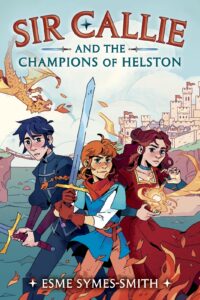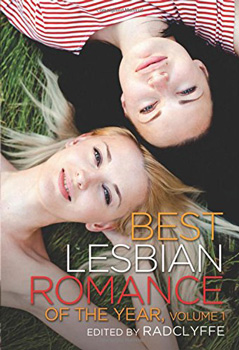“My name is Callie, and I’m not a girl. I am here as Papa’s squire, and I want to train as a knight.”
Content warnings: verbal and physical abuse from parental figures; internalized homophobia/transphobia; deadnaming; bullying; queer-coded distrust of magic; parental figure with implied depression; implied suicide of SC; death of sibling to SC; grief, anxiety and other traumas
Rep: nonbinary/sapphic MC; sapphic SC; genderqueer SC; gay parental figure; bi parental figure
I received an e-arc from Netgalley and Labyrinth Road free of charge, and my opinions are completely my own.
As an adult reading middle-grade, I am often wary of either reading a narrative that infantizes the reader or overestimates their experiences. When I read Sir Callie for the first time, I was delighted to see that I wouldn’t have to worry about that. Syme-Smith’s voice is an entrancing one, with their writing transporting the reader back to being twelve years old and having an idealized version of the world. Callie’s perspective on her family and her reactions to Helston’s intolerance feel incredibly true to not only the character that Syme-Smith skillfully crafted, but to tweens everywhere, regardless of sexuality or gender. Beyond Callie, the rest of the cast is as wonderfully wrought, whether you look at Elowen and her fierce determination for equality, at Willow and his fear of letting down his kingdom, or at Edwyn and his desire to please his father (the villain of the book) battling what he believes to be good and true. Even the adults shine as full-fledged characters who are not necessarily demons or angels, but rather are judged by their intentions and interactions with their privilege.
Sir Callie is a book that validates the childhood experiences of readers who have experienced prejudice, abuse from parental figures, and internalized and externalized queerphobia. I personally fell in love with Sir Callie because I felt seen—the things that happened to me as a child were acknowledged with a gentle hand, and I saw kinship in Willow’s struggles with magic and Elowen and Edwyn’s relationships with their parents. Readers of all ages can find healing amongst Callie’s family, both birth and chosen, as Symes-Smith assures us (through Nick) that as kids, our only job is to be a kid.
Of course, I cannot NOT talk about the queer representation within Sir Callie! We come into Callie’s story with them having realized that they are not cisnormative, and fast-forward to their identifying proudly as nonbinary. The words that Symes-Smith uses to describe being nonbinary are simple, and yet lifechanging. Here are one of my favorite quotes: “I wasn’t a she, and I wasn’t a he, I was just . . . Callie. Eventually, I put on “they,” and I haven’t taken those shoes off since.” Beyond the nonbinary representation, Symes-Smith makes having magic (and not being a girl) immensely queer-coded, especially when seen in Prince Willow, who is bookish and wants to please everyone around him. There is little to no romance in Sir Callie—the only romance blossoming is between Nick and Neal, Callie’s dads, and perhaps a slight crush on a certain girl…But no spoilers!
Sir Callie and the Champions of Helston (I dare you to say that five times fast) has become one of my absolute favorite middle grade books with its placing queer characters and realistic themes front and center. This is an incredibly important title that I can see being discussed in schools and library book clubs—and should be! The fantasy elements bring a bit of distance to a plot that discusses real life issues such as prejudice, intolerance, and abuse, and treats its readers with respect and care. The only real complaint that I could have about it is that the ending felt a little too perfect. However, Symes-Smith has since revealed that Sir Callie was just book one, and will be part of a four-book series. Sir Callie and the Dragon’s Roost is set to focus on obstacles outside of Helston and to show how fighting for justice never ends at getting rid of one villain.
Are you still not sure about reading Sir Callie? Well, if you like these books:
- The Last Unicorn, by Peter S. Beagle
- The Sun and the Star, by Rick Riordan
- The Witch Boy, by Molly Ostertag
- Dear Mothman, by Robin Dow
Then you’d definitely want to grab a copy of Sir Callie! You can get a copy of Sir Callie from your local bookstore or library, or you can get a copy through Bookshop.
Chloe (they/he) is a public librarian in Baltimore, who identifies as Indigenous, autistic, and panromantic demisexual. They enjoy reading queer literature for any age group, as well as fantasy, contemporary, and romance. In their spare time, they act in local community theaters, play D&D, and are halfway through their MLiS program. You can find them on Goodreads, Twitter, or Instagram.



